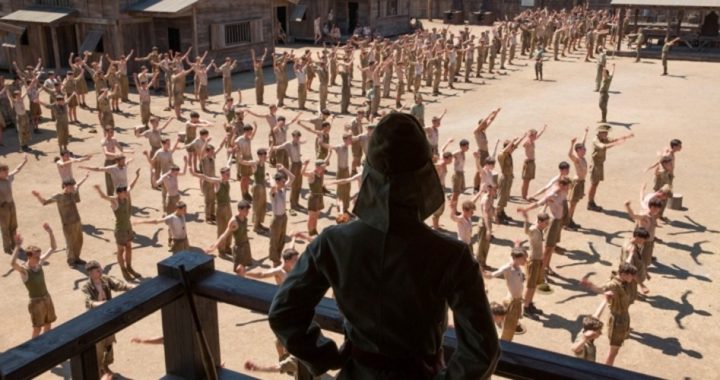
Unbroken is the kind of movie every viewer wants to like.
The true-life story of American Olympic runner and World War II POW Louis Zamperini, Unbroken is an inspiring tale of human endurance, but on the whole, it fails to impress as a movie. Directed by Angelina Jolie, this film is as visually stunning as it is bereft of character development and heart. Zamperini’s larger-than-life persona is reduced in Unbroken to a cardboard cutout, a man of steely resolve and irrepressible will whose motivation for so being is a complete cipher.
Louis Zamperini was the son of hard-working Italian immigrants who settled in Torrance, California, in 1919. He was evidently something of a delinquent, stealing cigarettes and liquor, running from the police, and generally making life difficult for his salt-of-the-earth parents. It was his older brother who encouraged Louis to develop his talent as a runner, an ability that turned him into a record-setting state champion and member of the 1936 U.S. Olympic team. The 1936 Olympics, of course, were notorious for taking place in Munich, under the watchful eye of the Führer himself. Zamperini later claimed that he shook Hitler’s hand and contrived to steal the Nazi leader’s personal flag, but the film inexplicably omits these events.
Unbroken opens with Zamperini and his fellow crewmen aboard a B-24 on a bombing run over the Pacific. The footage of the bombing and subsequent dogfights makes for the sort of CGI grandeur that is modern Hollywood’s bread and butter, but the ensuing story, unfortunately, never reaches any higher plateaus. Fortuitously returning their crippled plane to base, Zamperini and two of his fellow crewmen soon find themselves adrift in the Pacific after a subsequent mission in a less-than-airworthy plane ends up ditching in the sea, killing most of the crew.
Thus begins what is to be a more than two year ordeal of survival for Zamperini (and also, as it turns out, for his raft mate and friend Phillips, whose equally compelling story is truncated when the two become separated after their capture). The men are adrift in the equatorial Pacific for 47 days, fending off ravenous sharks, scorching heat, delirium, and starvation with little more than a pair of rubber rafts and the meager supplies they hold. For food they manage to capture an albatross (which turns out to be inedible), fish, and (in one of the film’s many improbable sequences) a sizable shark that they manage to catch and dispatch by hand. They also somehow survive strafing by a Japanese warplane (although a luckless shark does not), and, even though their rafts are shown with dozens of bullet holes, they successfully patch them all and keep one of them seaworthy — this, while ravenous whitetips circle and snap.
By the time they are found by a Japanese naval vessel, one of the three (Francis McNamara) has succumbed. Zamperini and Phillips are taken to an interrogation site on a tropical island before being transferred to POW camps in Japan.
It is in the relatively well-maintained confines of the Japanese prison camp that Zamperini’s real ordeal gets underway, with constant humiliation, abuse, and torment visited upon him by the camp’s sadistic overlord, Matsuhiro Watanabe (nicknamed “the Bird” by POWs). After two years of savage beatings and other creative torments, including an iconic scene in which Watanabe requires Zamperini to hold a heavy beam above his head for more than a half hour, and another in which every other POW in the camp is compelled to punch Zamperini in the face as hard as he can, the war ends, and Zamperini goes home to a hero’s welcome.
Most of Unbroken squares with Zamperini’s own account, as detailed in a book by the same name by Laura Hillenbrand. But the accuracy of some of the details has been called into question. Besides the improbability of being able to survive on the raft for 47 days, the abovementioned mass-punching scene is difficult to accept. After all, professional boxers and MMA fighters frequently land many dozens of punches in a bout, most of them partly deflected, parried, or countered, and all of them softened by gloves. But a solid punch to the face will usually knock a man — even an experienced fighter — senseless (Zamperini had practiced boxing as well as running). And even if that were not the case, the first two or three blows with bare knuckles will usually suffice to tear open skin. Orbital bones, teeth, and noses will succumb soon after. It is very difficult to imagine even Mike Tyson in his prime surviving more than 100 solid punches to the face, let alone an emaciated prisoner of war.
Yet if lapses in credibility such as these can be explained away by dramatic license, the same cannot be said of the actual character of Zamperini or anyone else in the film. What is it about the protagonist that gives him his will to survive? Surely it is not the brief pep talk delivered by his brother prior to an athletic competition. Perhaps it is the ethnically motivated bullying he endured as a boy — but then, we don’t see enough of the young Zamperini or his tormentors to know. Is it the inspirational example of his parents? Again, the audience is not given enough information to judge. And Zamperini (as well as his fellow POWs) has little to say during his ordeal to create an impression of his personality. He is, in other words, an utterly mundane, lifeless character, such as most of us would be if our lives were translated directly to film without any dramatic embellishment. By the film’s end, the audience, shell-shocked by Zamperini’s violent treatment, is relieved at his deliverance, but has not really gotten to know the man behind the bruises.
While Zamperini’s life was a tale of redemption and conversion (he became an evangelical Christian after several years of severe post-traumatic stress, and was a motivational speaker the rest of his life), these elements are muted in Jolie’s portrayal. Yes, there is the uplifting sermon near the beginning, as well as Zamperini’s desperate prayer in a storm-tossed raft, but the most redemptive elements in his story — his return to Japan years later to seek reconciliation with his tormentors and his life of Christian service — are relegated to a brief cinematic postscript. Thus Unbroken, while uplifting at intervals, comes off primarily as a bleak montage of torture and suffering. As one reviewer noted with more than a hint of irony, it could have been entitled “Triumph of the Will” — if that title not already been taken.
Zamperini’s heroic story has been knocking around Hollywood since the mid-1950s, but until now, no one has seen enough potential to turn it into a cinematic tale for the ages. Unfortunately, Unbroken, with its flat acting, muted dialogue, and improbable levels of violence and suffering, appears to have vindicated the doubts of several generations of filmmakers. For a better portrayal of the man and his improbable life, read the book.



